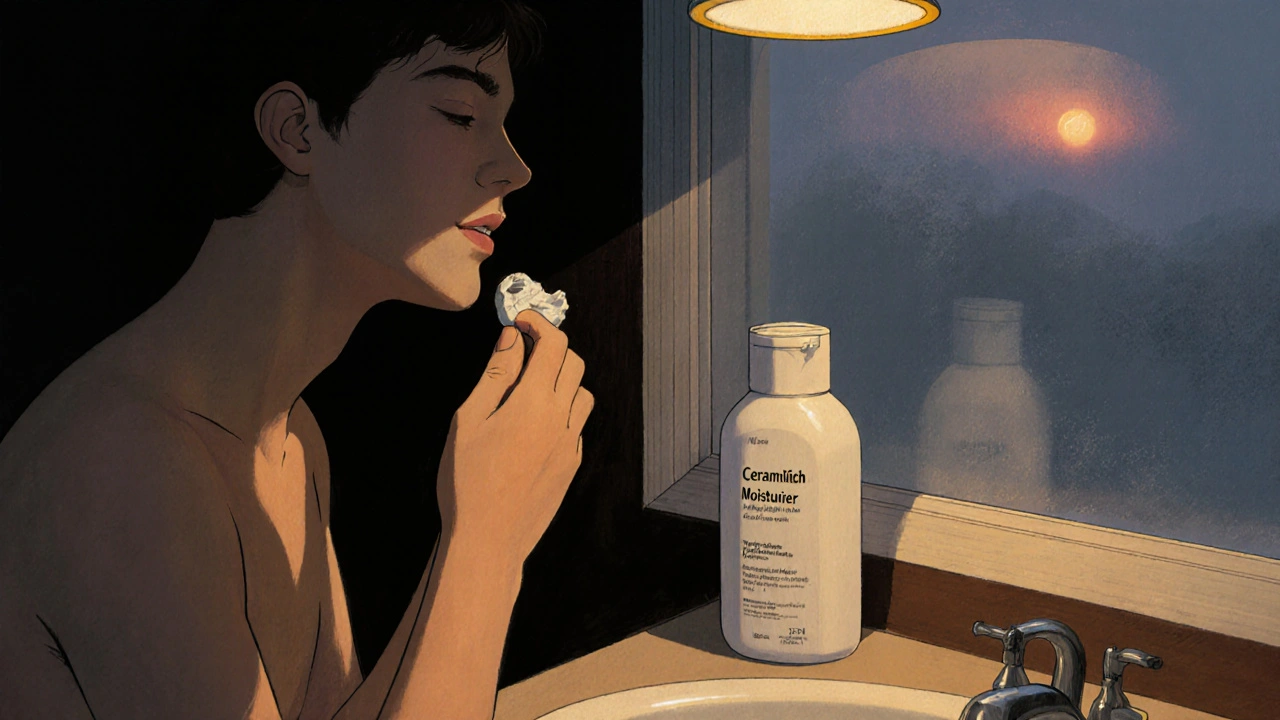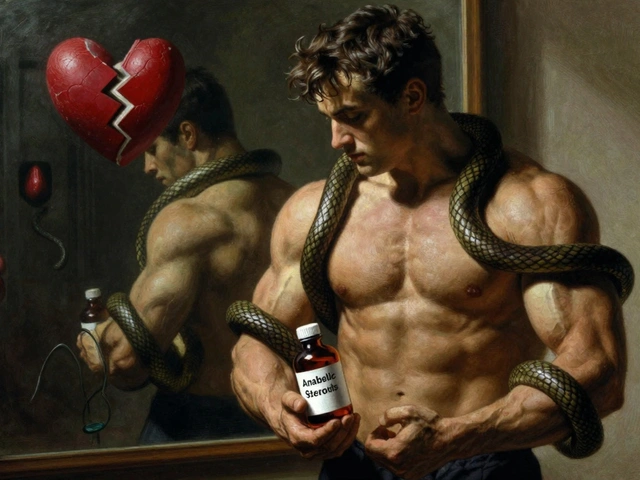Acne Treatment Decision Tool
Find Your Ideal Acne Treatment
Answer a few quick questions to get personalized recommendations based on clinical evidence from the article.
When you hear the word tretinoin, you probably think of a prescription‑only cream that clears stubborn acne. But is the 0.05% strength truly the best choice for every skin type? This article breaks down the science, side‑effects, and real‑world results of Tretinoin 0.05% and lines it up against the most common alternatives - so you can decide what actually fits your skin’s needs.
What Is Tretinoin 0.05%?
Tretinoin 0.05% is a topical retinoid formulation containing 0.05% (w/w) all‑trans retinoic acid. It works by binding to retinoic acid receptors (RAR) in keratinocytes, accelerating cell turnover, reducing follicular plugging, and modulating inflammation. The result is fewer comedones, faster resolution of existing lesions, and smoother skin texture. First approved by the FDA in the 1970s, it remains a gold‑standard prescription for moderate to severe acne vulgaris.
Why Compare? The Need for Alternatives
Even though Tretinoin works well for many, it’s not a one‑size‑fits‑all solution. Up to 30% of patients report irritation severe enough to stop treatment, especially during the first month. Moreover, the medication is photosensitizing, demanding strict sun protection. These drawbacks have driven dermatologists to consider other retinoids or non‑retinoid options that might be gentler, faster‑acting, or better suited for specific skin concerns such as hyperpigmentation.
Key Alternatives on the Market
Below are the most widely prescribed or OTC alternatives that dermatologists often recommend alongside or instead of Tretinoin 0.05%.
- Adapalene 0.1% - a third‑generation synthetic retinoid that targets RAR‑β and RAR‑γ, offering a lower irritation profile.
- Tazarotene 0.1% - a potent third‑generation retinoid that binds all RAR subtypes, useful for both acne and psoriasis.
- Benzoyl Peroxide 2.5% - an oxidizing agent that kills Cutibacterium acnes bacteria and reduces inflammation.
- Azelaic Acid 15% - a dicarboxylic acid with antimicrobial, keratolytic, and depigmenting properties.
- Salicylic Acid 2% - a beta‑hydroxy acid that exfoliates within pores, ideal for non‑inflammatory lesions.

Side‑Effect Profile: What to Expect
Understanding how each ingredient interacts with the skin helps you anticipate irritation, dryness, and other reactions.
| Ingredient | Irritation risk | Photosensitivity | Typical onset of side‑effects |
|---|---|---|---|
| Tretinoin 0.05% | High - erythema, peeling, burning | Significant - requires SPF 30+ | 1‑2 weeks |
| Adapalene 0.1% | Moderate - milder redness | Low to moderate | 2‑3 weeks |
| Tazarotene 0.1% | High - intense peeling | Moderate | 1 week |
| Benzoyl Peroxide 2.5% | Low - occasional dryness | None | Immediate to 5 days |
| Azelaic Acid 15% | Low - mild tingling | None | 1‑2 weeks |
| Salicylic Acid 2% | Low - occasional dryness | None | Immediate |
Effectiveness for Different Acne Types
Not all acne looks the same. Here’s how each option performs across the main categories.
- Comedonal (whiteheads & blackheads): Tretinoin and Adapalene excel by normalising desquamation. Tazarotene works too but may be overkill for mild cases.
- Inflammatory (papules, pustules): Benzoyl peroxide shines because it kills the bacteria that fuel inflammation. Combining it with a retinoid often yields the best results.
- Post‑inflammatory hyperpigmentation (PIH): Azelaic acid and low‑dose Tretinoin are both proven to fade dark spots. Tazarotene can also improve texture but is harsher.
- Sensitive skin: Adapalene, Azelaic acid, and Salicylic acid typically cause less burning than Tretinoin.
Practical Usage Tips & Regimens
Choosing a product is only half the battle; how you apply it matters just as much.
- Start Slow: Begin with a pea‑size amount of Tretinoin 0.05% at night, twice a week, then gradually increase to every other night.
- Moisturizer Buffer: Sandwich the retinoid between a gentle cleanser and a ceramide‑rich moisturizer to cut irritation in half.
- Sun Protection: Use a broad‑spectrum SPF 30+ daily, reapplying every two hours when outdoors.
- Combination Therapy: Pair benzoyl peroxide in the morning with a retinoid at night for synergistic acne control.
- Alternate Days: For very reactive skin, rotate Tretinoin with Adapalene or Azelaic acid to maintain efficacy while giving the skin a break.

Cost and Accessibility
Prescription strength matters for price. In the UK, a 30‑g tube of generic Tretinoin 0.05% costs around £12‑£20, depending on the pharmacy. Adapalene 0.1% (often sold as Differin) is available OTC for £8‑£15. Tazarotene requires a specialist prescription, pushing the price to £30‑£45. Benzoyl peroxide, Azelaic acid, and Salicylic acid are all sold OTC, typically under £10 for a month’s supply.
Choosing the Right Option for You
Below is a quick decision guide. Answer a few questions, and you’ll land on the most suitable alternative.
- Do you have very sensitive skin? → Start with Adapalene 0.1% or Azelaic Acid 15%.
- Is inflammatory acne your biggest issue? → Add Benzoyl Peroxide 2.5% to any routine.
- Are you battling post‑inflammatory hyperpigmentation? → Azelaic Acid or low‑dose Tretinoin are best.
- Do you need a fast‑acting, high‑potency solution? → Tazarotene 0.1% (but be ready for strong irritation).
- Looking for an over‑the‑counter starter? → Adapalene or Salicylic Acid are budget‑friendly.

Common Pitfalls & How to Avoid Them
Even the best product can fail if used incorrectly.
- Over‑application: A pea‑size amount covers the whole face. Using more won’t speed results; it just spikes irritation.
- Skipping Moisturizer: Retinoids thin the stratum corneum. Pairing with a barrier‑repair moisturizer prevents flaking.
- Neglecting Sun Protection: UV exposure can cause retinoid‑induced hyperpigmentation.
- Mixing with Incompatible Actives: Avoid using vitamin C serums at the same time as tretinoin; alternate mornings/evenings.
- Giving Up Too Soon: Most retinoids need 8‑12 weeks for maximal benefit. Patience is key.
Bottom Line: Is Tretinoin 0.05% Still the Best?
If you can tolerate its irritation, Tretinoin 0.05% remains one of the most effective acne treatments available, especially for stubborn comedonal lesions and long‑term skin texture improvement. However, for sensitive skin, early‑stage acne, or those looking for an OTC starter, alternatives like Adapalene, Azelaic acid, or Benzoyl peroxide can deliver comparable results with less discomfort.
Frequently Asked Questions
Can I use Tretinoin 0.05% and Adapalene together?
It’s generally not recommended to layer two retinoids because the irritation risk skyrockets. Instead, alternate nights or use one as a maintenance product after the other has achieved desired results.
How long does it take to see results with Tretinoin?
Most patients notice a reduction in new lesions within 4‑6 weeks, but full texture improvement and spot fading can take 3‑6 months of consistent use.
Is Tretinoin safe during pregnancy?
No. Retinoids are classified as Category C/D medications and should be avoided during pregnancy due to potential fetal risk.
What’s the difference between Tazarotene and Tretinoin?
Tazarotene binds all three RAR subtypes and is more potent, making it faster‑acting but also more irritating. Tretinoin is milder, better suited for long‑term maintenance.
Can I replace Tretinoin with Benzoyl Peroxide?
Benzoyl peroxide targets the bacteria behind inflammatory acne, but it doesn’t promote cell turnover. For comprehensive acne care, combine it with a retinoid rather than using it alone.






Heather ehlschide
If you’re just beginning tretinoin, apply a pea‑size amount at night and stick to every‑other‑night for the first two weeks. This low‑dose schedule cuts the initial redness and peeling dramatically.
Kajal Gupta
Think of adapalene as the gentle cousin of tretinoin – it still nudges dead skin cells away but does it with a softer hand, so you’ll notice less burning while still keeping those clogged pores in check.
Zachary Blackwell
Most people don’t realize that big‑pharma pushes tretinoin because it locks them into pricey prescriptions, while the milder alternatives like salicylic acid get tossed aside as “just over‑the‑counter” and never make the headlines.
Michaela Dixon
When you look at the skin barrier it is like a wall that can be both protective and stubborn it tries to keep moisture in while also blocking the escape of excess oil it is this delicate balance that retinoids like tretinoin aim to tip in your favor the active molecule slides into the keratinocytes and tells them to hurry up and shed the old dead cells the result is a fresher surface that can breathe better the irritation you feel at first is simply the skin reacting to this accelerated turnover it is not a sign of failure but a signal that you are on the right track the key is to calm the inflammation with a gentle moisturizer that contains ceramides and hyaluronic acid these ingredients act like a soothing blanket over the irritated patches the more you moisturize the less the peeling becomes painful over time the barrier repairs itself and you start to see fewer breakouts the process can take anywhere from four to six weeks for noticeable changes and up to three months for full texture improvement patience is essential because the skin does not reset overnight remember that sunscreen is non‑negotiable because the new cells are hypersensitive to UV light a broad‑spectrum SPF 30 or higher should be applied every morning and reapplied if you spend time outdoors the whole routine is a dance between exfoliation and protection and when you get the rhythm right the skin rewards you with a smoother, clearer complexion.
Dan Danuts
Mixing a benzoyl peroxide gel in the morning with a night‑time retinoid gives you a two‑pronged attack that clears bacteria while speeding up cell turnover, and you’ll usually see the pimples shrink faster than with any single product alone.
Dante Russello
When you layer retinoids with other actives, start with a clean, dry face; follow with a pea‑size amount of tretinoin; wait a few minutes before applying a barrier‑repair moisturizer, which will lock in hydration and reduce irritation; always finish with a broad‑spectrum sunscreen, because the newly exposed skin cells are highly photosensitive; remember that consistency beats intensity, so stick to a routine you can maintain, and you’ll notice steady improvement without the dreaded flare‑ups.
James Gray
Yo man that tipz are gold, i def will try the step‑by‑step routine, cant wait to see less zits and smoother skin, im sure it’ll work out!
Scott Ring
I hear a lot of folks struggle with the burning phase, so keeping the moisturizer rich and the sunscreen on point really helps the skin heal without feeling like it’s on fire.
Peter Richmond
In summary, choose a retinoid based on irritation tolerance, acne type, and budget, then support it with proper moisturization and sun protection.
Bonnie Lin
Start low, stay consistent.
sara fanisha
Just remember patience is key and the skin will thank you.